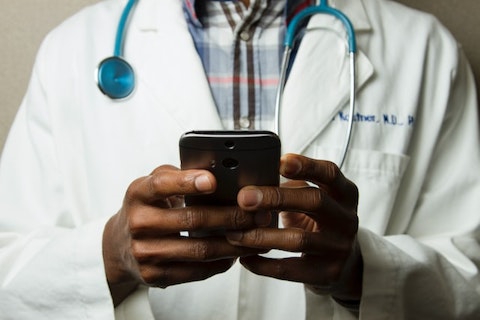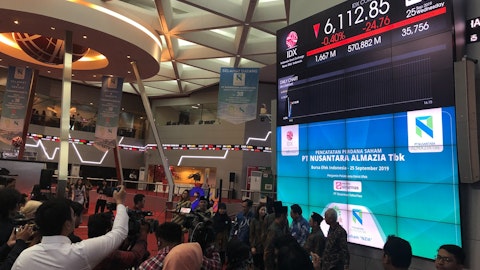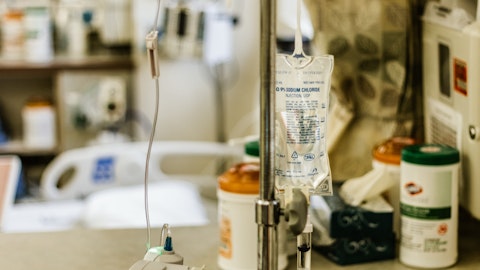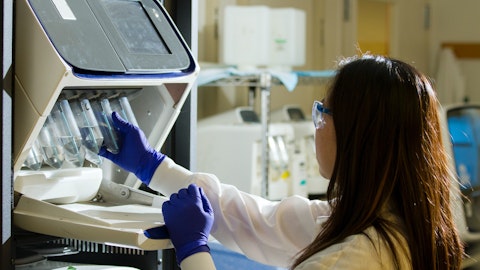Viatris Inc. (NASDAQ:VTRS) Q4 2022 Earnings Call Transcript February 27, 2023
Operator: Excuse me, everyone. Thank you for standing by. We apologize; we did experience some technical difficulties. We will now begin your conference. Please go ahead. Good morning, everyone. Welcome to our Q4 2022 Earnings and 2023 Guidance Call. With us today is our Executive Chairman, Robert Coury; CEO, Michael Goettler; Incoming CEO, Scott Smith; President, Rajiv Malik; and CFO, Sanjeev Narula. During today’s call, we will be making forward-looking statements on a number of matters, including our financial guidance for 2023 and various strategic initiatives. These forward-looking statements are subject to risks and uncertainties that could cause future results or events to differ materially from today’s projections. Please refer to today’s slide presentation and our SEC filings for a full explanation of those risks and uncertainties and the limits applicable to forward-looking statements.
We will be referring to certain actual and projected non-GAAP financial measures to supplement investors’ understanding and assessment of our financial performance. Reconciliations of those non-GAAP measures to the most directly comparable GAAP measures are available on our website and in the appendix of today’s slide presentation. An archived copy of today’s presentation and other earnings materials will be available on our website at investor.viatris.com following the conclusion of today’s call. With that, let me welcome Robert Coury.
Robert Coury: Good morning. When I spoke with you on November 7th, I shared my excitement for all that I saw ahead for Viatris as we begin to approach the end of Phase I of our strategic plan, which, as you know, has been our setup phase. And now as we prepare to enter Phase II beginning in 2024, I am pleased to report with our eighth consecutive successful quarter of execution behind us, the rebasing of our business model is well-underway. And though we are not giving guidance for 2024, I am even more confident today that we will not only generate a minimum of $2.3 billion of free cash flows, excluding transaction costs and taxes, but now also see the potential for accelerated top line growth from 2023 to 2024 as well. This is on top of the expected top-line growth you saw in this morning’s press release between 2022 and 2023 after excluding the full year impact of the biosimilars business in 2022.
Now turning to the other press release you saw this morning. The Board of Directors has appointed Scott Smith as Viatris’ new Chief Executive Officer, effective April 1st. Scott will lead the company in the execution of our previously and now Phase II strategy. Scott has been a member of the Viatris’ Board since December of 2022 and is a deeply knowledgeable senior global biotechnology pharmaceutical executive with over 35 years of experience, including as a former President and Chief Operating Officer of Celgene Corporation, where he built and oversaw the clinical development, registration, launch and global commercial success of the blockbuster drug, Otezla. Most recently, Scott has served as the President of BioAtla, a publicly traded global biotechnology company focused on the development of conditionally active biologic antibody therapeutics.
The Board view Scott as a seasoned builder who possesses vast global commercial and pharmaceutical expertise and a proven ability to build, grow and manage large complex organizations. We see his strong commercial and strategic expertise being complemented by his experience in organically building product franchises and executing business development and partnering activities. He also has substantial experience in the development of regulatory and clinical strategies that bring products to market. I personally have been very impressed with Scott’s overall approach to leadership, his deep industry knowledge and forward-looking business mindset. With our foundation now firmly in place and as we enter into Phase II of our strategic plan, the Board truly believes that Scott is well-positioned for success as he leads the growth of Viatris in the years ahead.
We are excited to welcome Scott and believe that he is absolutely the right choice to lead the company into the next phase of our journey. I’d now like to turn the call over to Scott to say a few words himself. Scott? _
Scott Smith: Thank you, Robert, and good morning to everybody on the call. It’s an incredibly exciting time to become Viatris’ CEO. I watch closely November as the company laid out the next important steps in its well-crafted strategic plan, including its commitment to its future capital allocation priorities, which I totally support. Since then and particularly after joining the Board and seeing their incredible level of engagement, I’ve been extremely impressed by everyone that I’ve met during this process and have also been inspired by all that has been accomplished in such a short period of time. I strongly identify with Viatris’ culture, which, when combined with the company’s strategic forward-looking mindset, makes it a natural fit for me.
Just as importantly, I’m also motivated by the company’s strong financial profile and financial flexibility, which has one of the strongest balance sheets in the sector. I can see many additional opportunities and options for Viatris to accelerate its growth in the coming years. I believe that my franchise building, business development and recent biotech experiences, coupled with the great platform we have to work from can accelerate Viatris’ momentum and help deliver on its full value and potential. I would like to thank Robert and the Board for this amazing opportunity and look forward to collaborating with Michael during this transition. I am very excited about the prospect of working with the Board, Rajiv Malik, Sanjeev Narula, and the entire management team on the execution ahead.
And lastly, to the company’s 37,000 employees, I am honored to have the opportunity to serve each of you and look forward to working with all of you in the near future as we continue to deliver on Viatris’ mission to empower people worldwide to live healthier at every stage of life.
Robert Coury: Thank you, Scott. The Board and I very much look forward to supporting Scott during the execution of our Phase II strategy, while continuing to remain focused on identifying additional opportunities to further unlock value for our shareholders. Also, as Scott mentioned, Michael will be working closely with him to support a smooth transition and will then step down as CEO and as a member of the Board of Directors on April 1 of this year. I and the Board would like to personally thank Michael for his service and his dedication during this critical time of the creation of Viatris and the establishment of the ongoing execution of our Phase I strategy. We wish him nothing but the best as he moves forward. With that said, I do look forward to answering your questions in the Q&A session.
But for now, I’d like to turn the call over to Michael, so he can add a few comments and then also lead the walk-through of our 2022 fourth quarter and full year earnings. Michael?
Michael Goettler: Thank you, Robert. We began this journey three and a half years ago, when we first made plans to embark on an unprecedented endeavor to combine Mylan and Upjohn to create a company that would spend the divide between generic and branded medicines to more fully address patients’ expectations and needs around the world. That’s been my sincere honor to serve as Viatris’ first CEO for the past two years. The opportunity to create a new kind of global health care company has been experienced that I will never forget. And I want to thank Robert, the entire Viatris Board of Directors, Rajiv, Sanjeev, my leadership team, but most especially all of all Viatris’ colleagues around the world whose tireless effort laid the foundation for what I believe to be a truly bright future.
As Viatris now embarks on its Phase 2 of a strategic plan, this is now a natural time for a transition. And I’m pleased to welcome Scott into Viatris, I’m looking forward to supporting him during this transition as he is now well positioned to continue to build on the company’s momentum. And now, as usual, here are some highlights for 2022. Quarter four was another strong quarter, in line with our expectations, take into account the Biocon transaction and IPR&D accounting. For Viatris, this is the eighth consecutive quarter of strong operational performance, closing out another strong year. In 2022, we delivered total revenue of approximately US$16.3 billion, adjusted EBITDA of approximately US$5.8 billion and free cash flow of approximately $2.5 billion on a reported basis, at approximately $2.8 billion after adjusting for the transaction costs and taxes associated with the Biocon transition.
This strong performance has not only enabled us to continue to deliver on our Phase 1 commitments, but has also built a solid foundation, setting our company up for 2024 and beyond. Our integration plans have captured approximately $750 million in synergies to date, and we’re well on track to capture at least $1 billion of cost synergies by the end of Phase 1 and we’ve exited substantially all the transitional services agreements with Pfizer. As of the end of 2022, we’ve paid down approximately $3.3 billion for the year-end debt and approximately $5.4 billion since the beginning of 2021. We continue to exercise financial discipline, maintaining our investment-grade rating, and continuing to reduce our gross leverage towards our long-term target of three times.
We’re returning capital to shareholders. Our Board of Directors just has approved a 2023 dividend policy of $0.48 per share and has declared a first quarter dividend of $0.12 per share. And cumulatively, since the formation of the address, we’ve already returned nearly $1 billion to shareholders through dividend payments alone. In January and February of this year, we’ve executed $250 million of our $1 billion share repurchase authorization. Now combined with the projected annual dividend, this represents an increase to date of more than 40% in return to shareholders over 2022 or put it another way, 33% of the midpoint of our free cash flow guidance for 2023. In addition to that, we’re continuing to execute on our plans to reshape our company for the future.
In November, we completed our transaction with Biocon Biologics to create what we expect to be a unique, fully integrated global biosimilars leader. And as we provide transitional services to Biocon, we’re deeply committed to doing our power to help Biocon Biologics succeed. In January, we completed the acquisitions of Oyster Point Pharma and Famy Life Sciences to establish our new Viatris Eye Care division. And as we said, we anticipate the combined assets of these acquisitions to add to the top line immediately and growing strong double-digits from there, reaching at least $1 billion in sales by 2028. Coupled with the strength of our organic pipeline, especially our complex injectables and novel products franchises, both of which also have the potential to reach $1 billion in peak net sales each by 2028.
This kind of business transaction is a very important component of our strategy. And finally, we remain on track to execute our planned and announced divestitures. Today, we’ll also be sharing the 2023 full year guidance ranges for total revenue, EBITDA and free cash flow, which Sanjeev will give more details on in a moment. Let me summarize. By being laser-focused on our Phase 1 priorities, integrating the two organizations, generating $1 billion in cost synergies, deleveraging the balance sheet and strengthening the balance sheet, paying down at least $6.5 billion in debt, reducing our gross leverage towards our long-term target of three times, maintaining our investment-grade credit rating, returning capital to shareholders through quarterly dividends and the share repurchase programs and reshaping the company through key divestitures and acquisitions, we are successfully stabilizing the business.
And as a result, although we’re not giving guidance beyond 2023, we’re confident in our expectation that 2024 will begin a period of renewed growth of Viatris and generate at least $2.3 billion in free cash flows per year, excluding transaction costs and taxes, of which we intend to earmark approximately 50% annually to be returned to shareholders in form of dividends or share repurchases. And now for one final time, let me turn it over to Rajiv and Sanjeev to share more details. Rajiv?

Photo by National Cancer Institute on Unsplash
Rajiv Malik: Thanks, Michael, and good morning, everyone. 2022 was another solid year of business execution and performance. We met our stated commitments, including delivering the pipeline, integrating and capturing synergies and most importantly, stabilizing the base business. We are really excited with how we see 2023 shaping up, and nothing has changed from what we shared with you on November 7 as we prepare for 2024. Our path to return to growth in Phase 2 is clear and now it’s about continued execution, which is what we do best. One of the key drivers behind the stability of our business is the understanding and effective management of our established brands. This was further evidenced by the better than expected performance of this category in 2022, driven by year-over-year growth from brands like Creon, Lipitor, Celebrex, Dymista and Yupelri while Norvasc and Amitiza and Effexor held JANZ ground.
We expect this stabilization to continue into 2023 and beyond. Let me now turn to the commercial segments and our expectations for this year. I will be making certain comparisons to 2022 results on a constant currency basis, which excludes the negative impact of foreign exchange, as well as excluding the biosimilars business from 2022. Our 2023 business is on a growth path. We expect to deliver approximately $500 million in new launches, plus $56 million in revenue from Tyrvaya, which more than offsets 2.9% erosion of our base business. As Robert mentioned in his prepared remarks, while we are not giving guidance beyond 2023, we see the potential for accelerated top line growth as we go into 2024 and beyond. Developed Markets grew by 1% in 2022 on the strength of European growth, offsetting the decline in North America.
For 2023, we expect this segment to remain flattish. Europe grew by 4%, primarily driven by the stability of our branded business, new launches and a strong performance from countries like France and Italy. In 2023, we believe we are well positioned to further grow this region by 3%, led by brands like Creon, Influvac, Lipitor and our thrombosis portfolio. In North America, despite the solid performance of Yupelri, the business declined by 4% as we navigated the competitive headwinds on key products like Wixela and loss of exclusivity on Miacalcin and Perforomist. We project Yupelri to continue to have strong double-digit growth in 2023, which will help offset the continued competitive pressures on certain key products. These market dynamics will be the primary reasons for our expectation of an approximate 3% decline in 2023.
That said, we are excited and look forward to bringing several new products, including generic Symbicort to market this year. Greater China again performed strongly and grew by 3% year-over-year, despite COVID lockdowns in this region. Our hospital business performed relatively better than retail. We believe China has significantly improved the cost efficiency of the medical reimbursement funds, while achieving their goals of providing the broader coverage of health care to its population through the successful implementation of VBP and other policies. At the same time, market has evolved towards publicly reimbursed channel and private paid channels. We have made significant progress in adapting our business model to the evolving market dynamics, while focusing on value-added activities to help patients manage their chronic disease states more effectively.
These investments are helping us expand the private pay market and also leverage our brand equity in this channel. Keeping in mind the evolving policy framework, we have modeled a small year-over-year decline for 2023. Emerging markets performed in line with expectations and benefited from a solid performance of the overall branded business, led by markets such as Middle East, Turkey and Korea. Going into 2023, we are projecting this segment to grow by 4% year-over-year, primarily driven by our branded business. Our Gen segment performed in line with our expectations, while continuing to be impacted by the comment driven price regulations in this region. While our brand Creon grew both in volume and value, our other two key brands, Amitiza and Effexor showed solid volume growth in 2022.
We anticipate strong volume growth to continue for our key brands for 2023. This segment is expected to decline by 4% in 2023. Now let me turn to our newly formed Eye Care division. We are pleased with the tailwinds that we expect with Tyrvaya in 2023. Since the beginning of this year, Medicare Part D coverage has grown from 2% to 32.5% of covered lives. We also launched a 90-day script program, and we are already seeing an uptick in the total prescriptions midway through this high deductible period of the year. We are significantly investing in the business and intend to launch a direct-to-consumer campaign in the fourth quarter of this year that is anticipated to start delivering results in early 2024. Switching to our deep eye care pipeline.
Our NDA review for reversal of mydriasis program was accepted and has been granted a PDUFA date of September 28 of this year. We have made the decision to terminate our Stage 1 Neurotrophic Keratopathy program because it failed to meet the primary endpoint in the Phase II OLYMPIA study. We have started enrollment in the first pivotal Phase III trial for presbyopia and are also on track to initiate the first Phase III study for the treatment of blepharitis in 2023. With the positive momentum of Tyrvaya and continued progress in our pipeline, we remain confident that our Eye care division will deliver $1 billion in net sales by 2028. 2022 was a very productive year from a science perspective. We are very pleased with the progress of our Complex injectable pipeline.
Currently, we have 10 ANDAs under review with FDA and have secured several first-to-market generic product opportunities such as Sandostatin LAR, Ozempic, Wegovy and Abilify Maintena. We expect to file a number of complex injectables in 2023, including MR-117 for the treatment of breast cancer, MR-150 indicated for use in the iron deficient anemia and MR-151 for the use in the treatment of certain bleeding disorders. Our novel and complex product programs have also progressed well in 2022. As you are aware, our partner, Mapi, has successfully completed the Phase III trial for our Glatiramer Once Monthly, and we are on track to submit this NDA to FDA by this April. We have also initiated a Phase III trial for expanding the indication of Effexor ER in Japan and have also made good progress on the recruitment of subjects into our Xulane Low Dose clinical program.
Looking ahead into 2023, we believe we are well positioned to initiate Phase III trial for our meloxicam rapid onset of action dosage form, which we believe has opioid sparing attributes. We also remain on track to initiate our clinical program for our biosimilar to Botox later this year. For our core and complex generics, we made over 100 additional submissions globally in 2022, and we expect to see this trend continue through 2023. Our program for complex generic MR-153 indicated for treatment of type 2 diabetes and MR-154 indicated for the treatment of SMA are well on track. For China, products were filed with FDA in 2022, including generic Symbicort. And we plan to submit additional 10 products this year in China. Our operations had yet another year of solid performance, delivering high customer service levels, and we see this strength continuing throughout 2023.
From an integration point of view, we were able to exit substantially all the transition services with Pfizer in 2022 and are well on our path to achieve $1 billion in cost synergies by end of this year. Before I conclude, I would like to thank our colleagues for their hard work and commitment that delivered another year of strong performance. With that, I will now hand the call over to Sanjeev.
Sanjeev Narula: Thank you, Rajiv and good morning, everyone. Let me start with what you heard from Robert, in particular as it relates to 2024. We continue to feel confident about the starting point for Phase II as communicated in November of last year, and nothing has changed from then to now. As mentioned, although we are not giving guidance beyond 2023, we expect to have at least $2.3 billion in free cash flow from the underlying business in 2024 before any divestment cost and taxes. This reflects the expected cash flow generation after removing the planned divestiture. 2022 was another strong year for the company, enabling us to deliver on our Phase I commitment, while further investing in our business. We’re taking bold steps in reshaping the company and remain confident in our strategy to return to growth in Phase II.
Moving to slide 26. We finished the year on a strong note across total revenue, adjusted EBITDA, and free cash flow and results were in line with our expectations. Recall that our previous guidance included full year contribution from biosimilar business. As a result, because of the Biocon transaction closing in late November, we’re adjusting our guidance down by approximately $86 million in total revenue, $31 million in adjusted EBITDA, and $20 million in free cash flow relating to the exclusion of results since closing. Also impacting adjusted EBITDA and free cash flow was $36 million of acquired IPR&D, which was not included in the guidance. Free cash flow also impacted by $254 million of transaction cost and taxes related to the Biocon transaction.
Excluding this impact, free cash flow would have been $2.8 billion on a full year basis. Now, turning to slide 27. Revenue was impacted by foreign exchange, given our significant international operation. Excluding this impact, we’re encouraged by the operational stability and diversification of our global portfolio. As mentioned on the third quarter call, we anticipated adjusted gross margin to moderate in Q4 due to continued inflationary headwinds and product mix. On a full year basis, adjusted gross margin came in at the high end of our expectation at 58.9%, driven by strong brand performance. Adjusted SG&A and adjusted R&D came in line with our expectations and included certain investments we made in Q4 to support our 2023 plan. We had a very strong year of cash flow generation, reflecting our underlying operational performance and continued organizational priority on cash optimization initiatives.
As mentioned before, free cash flow in fourth quarter was impacted by Biocon transaction. And excluding this would have been $243 million in Q4 2022. Slide 28 illustrates the uses of the upfront cash proceeds received upon the closing of Biocon transaction. It is important to note that the gross proceeds of approximately $2 billion are included in the cash flow from investing activities. While the related tax and transaction costs are included as negative cash flows, from the operating activities. The net proceeds, serve to accelerate debt pay down, fund the eye care acquisition and execute on share repurchase in Q1 2023. Slide 29 illustrates the continued prioritization of debt pay down, which has resulted in total paydown of approximately $5.4 billion over the last eight quarters.
As a result, and irrespective of divestiture proceeds, we expect to meet our commitment of paying down at least $6.5 billion during Phase 1. We exited 2022 with a gross average of approximately 3.2 times. These deliberate actions taken by the company reinforce our commitment to the investment-grade rating. Another priority is returning capital to our shareholders, which included approximately $580 million in dividend in 2022 and more than $980 million, since the beginning of 2021. Slide 31 and 32 speak to the assumptions and guidance for 2023, which we expect to be a bridge year to get to our starting point in 2024. In 2023, we expect continued strengthening of our financial profile, which includes, our expectation that total revenue will grow versus 2022, excluding the contribution of biosimilar.
Investment into Eye Care Division and our strong pipeline for future growth, another strong year of expected free cash flow generation and our capital allocation framework, which includes debt paydown and significantly enhanced, capital return to our shareholders. As previously mentioned, the timing of planned divestiture may create fluctuation in our future reported results. The guidance we presented today includes the anticipated full year performance of businesses that we expect to divest. Similar to Biocon transaction, we will provide as much transparency as possible on the expected impact to our guidance and results as and when these transactions are announced. As it relates to key metrics, we expect slight moderation in our gross margin relative to 2022 levels this includes the expected pricing impact on key products, base business erosion and the continued inflation impact.
With respect to acquired IPR&D, we do not include any amount in our guidance related to unsigned deal. Now let me explain the anticipated phasing for this year. We expect total revenue and adjusted EBITDA to be higher in the second half, due to ramp up new products and normal product seasonality. Specifically, we expect Q1 to be the lowest quarter for the total revenue and adjusted EBITDA. We estimated free cash flow will be evenly weighted between first half and second half. In general, Q2 and Q4 tend to be lower due to timing of semiannual interest payments. It is important to note, in the revenue guidance walk on slide 33, the 2022 adjusted number of $15.65 billion excludes the 11-month biosimilar revenue included in our reported results.
On a comparable basis, at the midpoint of revenue guidance, we expect total revenue of the underlying business will grow in 2023. Based on January FX rate, full year guidance assumes minimum foreign exchange impact on total revenue, adjusted EBITDA and free cash flow. We remain encouraged by the operational performance of our segment, stability in global brands and expectation of approximately $500 million in new launches. In addition, we expect $56 million in revenue from Tyrvaya of our new eye care product. On Slide 34 are few items that will impact adjusted EBITDA. First, we expect adjusted gross margin to be impacted from continued competition on key products. Next, adjusted gross margin of new products is expected to be above the company average.
Third, we’re investing in Eye Care division, which includes commercial infrastructure and DTC investment in the second half of the year. We’re making further investment to advance the deep Phase 3 ready eye care pipeline. And lastly, other bucket includes the impact of continued inflation and investment with some offsetting benefit, including synergies. Turning to Slide 35. We expect another strong year of free cash flow generation as a result of expected lower onetime cash cost and continued focus on cash optimization initiatives. On Slide 36, I will now turn to our financial commitment, including return of capital to shareholders. To start, we have completed $250 million of share buyback or the previously announced $1 billion repurchase authorization.
In addition, we anticipate an annual dividend of $0.48 per share. Taken together, this will increase our capital return by over 40% versus 2022. This represents a minimum payout of approximately 33% of the midpoint of free cash flow guidance. In addition to capital return, we will continue to prioritize debt reduction and expect to pay down our scheduled maturity of $1.3 billion in 2023, and thereby, we expect to deliver on our commitment of $6.5 billion of debt paydown in Phase 1. This is irrespective of proceeds from the divestiture. This is continued evidence of progress towards our stated gross leverage target of three times. Within an extraordinarily strong financial position and are benefiting from our investment-grade rating in this rising interest rate environment, with nearly all of our capital structure being fixed rate, we expect interest expense for 2023 to be flat versus 2022.
In closing, we are well positioned for a strong start in 2023, which we considered our bridge year. The reshaping initiative will serve to strengthen the company and set us up well heading into 2024 and beyond. With that, I will hand it back to the operator to begin Q&A.
See also 11 Most Undervalued Biotech Stocks and George Soros’ Top 15 Holdings.
Q&A Session
Follow Viatris Inc
Follow Viatris Inc
Operator: Thank you. At this time, we will open the floor for questions. We’ll take our first question from Chris Schott with JPMorgan.
Chris Schott : Great. Thanks so much for the question. Maybe just a bigger picture one to start out. I’m just trying to get my hands maybe a question for Robert and Scott. Just trying to understand the timing of the CEO transition here a bit more, I guess, it seems like you laid out a strategy kind of last fall. It seems like we’re in the midst of kind of a divestiture repositioning of the company right now. So can you just talk a little bit about kind of why now on the transition versus either, before we went down this process or a later in the process? And if I just got a second clarification one on the 2024 free cash flow number, I know you’re not giving formal guidance, but that $2.3 billion of free cash flow, just are on the same page, can you just elaborate what’s included in that number as we think about whatever you can say on EBITDA versus one-time costs, what you have for divestitures, et cetera?
I think just trying to make sure we’re in the right adjustments to the $2.3 billion. Thanks so much.
Robert Coury: First, I would not say that we’re repositioning the company at all. I would say the news today is all about preparation, not change. I think — as you look from day one, we laid out a two-phase process. Phase 1, which had to do all about integration, synergizing and really execution in bringing the two organizations together. We believe that Michael leading the Upjohn division at that time, Sanjeev’s rolled at that time, we felt that those two leaders coming together with our leadership was the absolute right leadership for Phase 1. And it’s really demonstrated and proved out to be actually the perfect right decision because the company has been stabilized, the organization has been integrated, our synergies are well on target, so this is — and then, of course, in November 7, we — the Board of Directors and management, we laid out a very clear strategy for Phase 2.
So once you lay out that vision, once you understand what the strategy is, and then you put together an execution plan, the simple last step is who is the right leader with the right background to support that strategy going forward. So really, this is a very natural, authentic handoff from Michael to Scott, when you look at the both backgrounds but you should expect that this is not a repositioning or a change or a change in strategy. In fact, I think, Scott in his prepared remarks has said so. But Scott, let you say a few words about your view of this.
Scott Smith: Yes, I want to thank you for the question, Chris, and I want to be very, very clear, I fully support the strategy that’s been laid out, including the capital allocation strategy. On the November 7 strategic reset, certainly caught my attention. And then being on the Board since late 2022, I’ve had a chance to really deeply understand the strategy and where it’s going, and I fully support it. The strategy and the way it’s laid out is part of what made this opportunity very attractive to me. And I’m here to work with the team to execute it, not to deviate from it.
Robert Coury: Sanjeev, do you want to hit this?




